Biodiversity strategy and delivery plan: strategic environmental assessment
Strategic environmental assessment (SEA) for the Scottish biodiversity strategy and delivery plan.
Non-Technical Summary
The SBS & Delivery Plan
The Scottish Government has recently prepared a draft Delivery Plan for the recently published Scottish Biodiversity Strategy (SBS).
The original biodiversity strategy was made up of two parts. Scotland's Biodiversity: It's in Your Hands was published in 2004 and set out a strategy for conserving Scotland's biodiversity to 2030. Secondly, the 2020 Challenge for Scotland's Biodiversity was published in June 2013. This document showed how the Scottish Government, its public agencies, Scottish business and others could contribute to the Strategy's aims and to reflect Convention on Biological Diversity International Aichi targets set for 2020.
In the period since its adoption, the Scottish Government has endorsed a number of international and national commitments, including associated with the following:
- The Paris Agreement, a legally binding international treaty on climate change.
- The Scottish Biodiversity Strategy Post-2020: Statement of Intent (2020)[1] which sets the direction for a new biodiversity strategy which will respond to the increased urgency for action to tackle the twin challenges of biodiversity loss and climate change. This includes a commitment to extend the area protected for nature in Scotland to at least 30% of Scotland's land area by 2030.
- The First Minister's endorsement of the Leaders' Pledge for Nature in November 2021, where world leaders have committed to reversing nature loss by 2030 and delivering a nature positive world.
- The adoption of the Kunming-Montreal Global Biodiversity Framework (GBF) negotiated at COP15 in 2022. The GBF aims to address biodiversity loss, restore ecosystems and protect indigenous rights.
In light of these commitments and ambitions and given the urgent nature of the ongoing twin crises of biodiversity loss and climate change, it was recognised that Scotland must develop a new biodiversity strategy which safeguards and enhances ecological functions.
As such, the new SBS seeks to out a nature positive vision for Scotland – one where biodiversity is regenerating and underpinning a healthy and thriving economy and society and playing a key role in addressing climate change. The SBS will be implemented through a series of Delivery Plans, covering a five-year period.
This Strategic Environmental Assessment Environmental Report accompanies consultation on the first Delivery Plan, which covers the period 2023 to 2028. The Delivery Plan sets out a series of 33 priority actions, accompanied by in the region of 145 detailed actions.
Strategic Environmental Assessment for the Scottish Biodiversity Strategy
To support the development of the SBS & Delivery Plan, an independent Strategic Environmental Assessment (SEA) is being undertaken.
SEA is a systematic process for evaluating the environmental consequences of proposed plans, programmes and strategies to ensure environmental issues are fully integrated and addressed at appropriate stages of decision making, with a view to promoting sustainable development. The SEA is a means of supporting the evidence base for the SBS & Delivery Plan, and for providing an opportunity for proposals and alternative approaches to be effectively evaluated in terms of their likely significant effects on the environment. It is being undertaken in line with the procedures prescribed by the Environmental Assessment (Scotland) Act 2005.
The key stages of the SEA process for the SBS & Delivery Plan are set out overleaf:
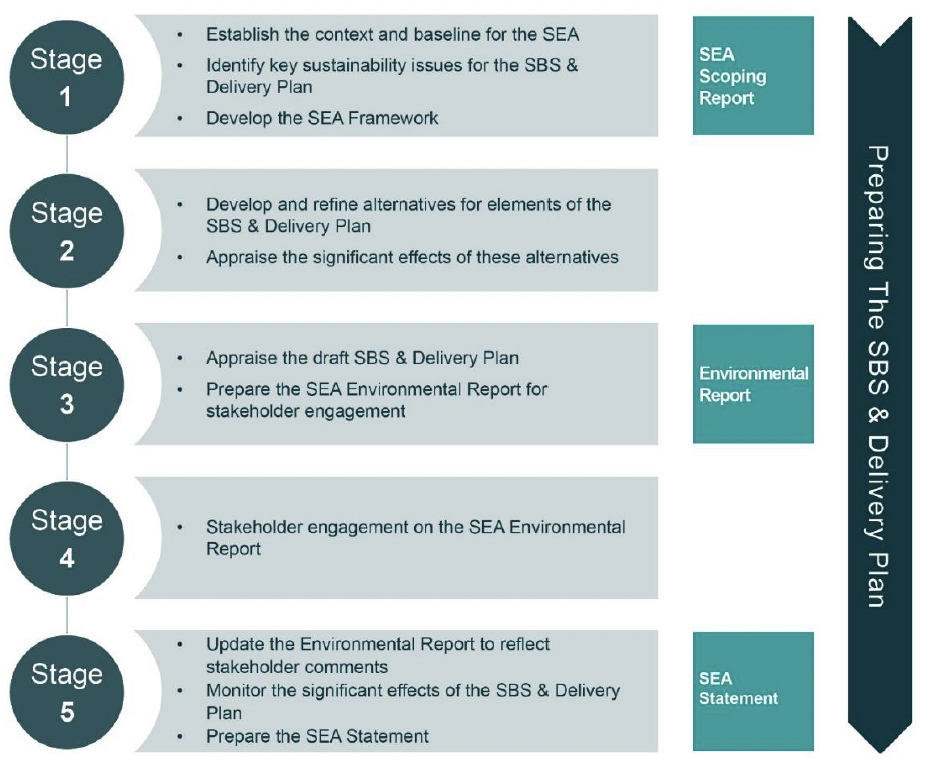
Purpose and content of this Environmental Report
This Environmental Report, which is the main output of the SEA process, accompanies the Delivery Plan for consultation between September and November 2023.
Its purpose is to:
- Identify, describe, and evaluate the likely significant environmental effects of the SBS & Delivery Plan and alternative approaches.
- Provide a perspective on the likely environmental performance of the SBS & Delivery Plan and key areas for monitoring during its implementation; and
- Provide an opportunity for statutory consultees, interested parties and the public to offer views on the SEA process carried out to date.
The Environmental Report is the third document to be produced as part of the SEA process for the SBS. The first document was the joint SEA Screening and Scoping Report (February 2022), which included information about the baseline against which the SBS would be assessed and the 'framework' against which the SBS has been assessed. The second document was an updated version of the Scoping Report for stakeholder comment (February 2023).
In line with the provisions of the Environmental Assessment (Scotland) Act 2005, this Environmental Report presents:
- An overview of the scoping process for the SEA
- An assessment of alternative approaches that can be taken to key elements of the SBS & Delivery Plan
- An assessment of the current version of the SBS & Delivery Plan, in terms of the likely significant environmental effects of the proposals
- Proposals for monitoring the significant environmental effects of the SBS & Delivery Plan.
- The next steps for the SBS & Delivery Plan and accompanying SEA process.
The information presented in this Environmental Report has been presented through the following nine SEA topics:
- Biodiversity, flora, and fauna
- Climatic factors
- Air
- Water
- Soil
- Cultural Heritage
- Landscape and geodiversity
- Material Assets
- Population and human health
Assessment of reasonable alternatives for the SBS & Delivery Plan
The assessment of 'reasonable alternatives' is a key element of the SEA process to meet the requirements of the Environmental Assessment (Scotland) Act 2005.
A central facet of the SEA process to date has been the appraisal of 'reasonable alternatives' for the SBS & Delivery Plan. The Environmental Assessment (Scotland) Act 2005 is not prescriptive as to what constitutes a reasonable alternative, stating only that the Environmental Report should "identify, describe and evaluate the likely significant effects on the environment of implementing the plan…and reasonable alternatives to the plan… taking into account the objectives and geographical scope of the plan…"
In developing reasonable alternatives for the SEA, a central consideration has been with respect to the key policy choices being made for the SBS. In this regard this Environmental Report has assessed a range of options as reasonable alternatives, with a view to exploring the options with particular potential for significant environmental effects. These assessments are designed to inform plan makers and stakeholders on the relative sustainability merits of alternative approaches the SBS could take on various strategy and delivery plan issues.
Development of options to assess as reasonable alternatives
In developing options to assess through the SEA process, the SEA team engaged plan-makers and stakeholders to understand where the focus of alternatives assessment should be. To aid in these discussions, two workshops were undertaken with key stakeholders to discuss reasonable alternatives in the context of the SBS. The purpose of these workshops was to discuss what options can be assessed as reasonable alternatives for the SBS, in conjunction with the objectives, key issues, challenges and opportunities associated with the strategy and delivery plan elements of the SBS.
The options formulated through these workshops relate to the following:
- Options exploring whether an ecosystem or a 'flagship species' approach to the SBS should be taken to the SBS.
- Options to explore whether the restoration of specific ecosystems should be focussed on through the SBS.
- Options relating to the implementation of SBS, including the appropriateness of sector specific strategies or plans.
- Options to explore whether SBS Delivery Plan actions should have a shorter term or longer-term timeframe, including relating to the 2030 and 2045 targets for biodiversity.
Chapter 5 of this Report presents details of the options assessed and the reasoning behind their choice as reasonable alternatives. This is accompanied by an assessment of the options against the SEA Framework developed during scoping. Infographics presenting summary appraisal findings for each set of options are also set out in Chapter 5 and reproduced overleaf.
Presented in relation to the nine SEA topics, the infographics show the relative performance of each option against each other. The green 'outer ring' is used to highlight where options are best performing (ranking 1st), while the red 'inner ring' represents the option which performs less well (ranking 2nd). Where options are ranked equally, or it is not possible to differentiate between the options, an equals sign is used within both diagrams.
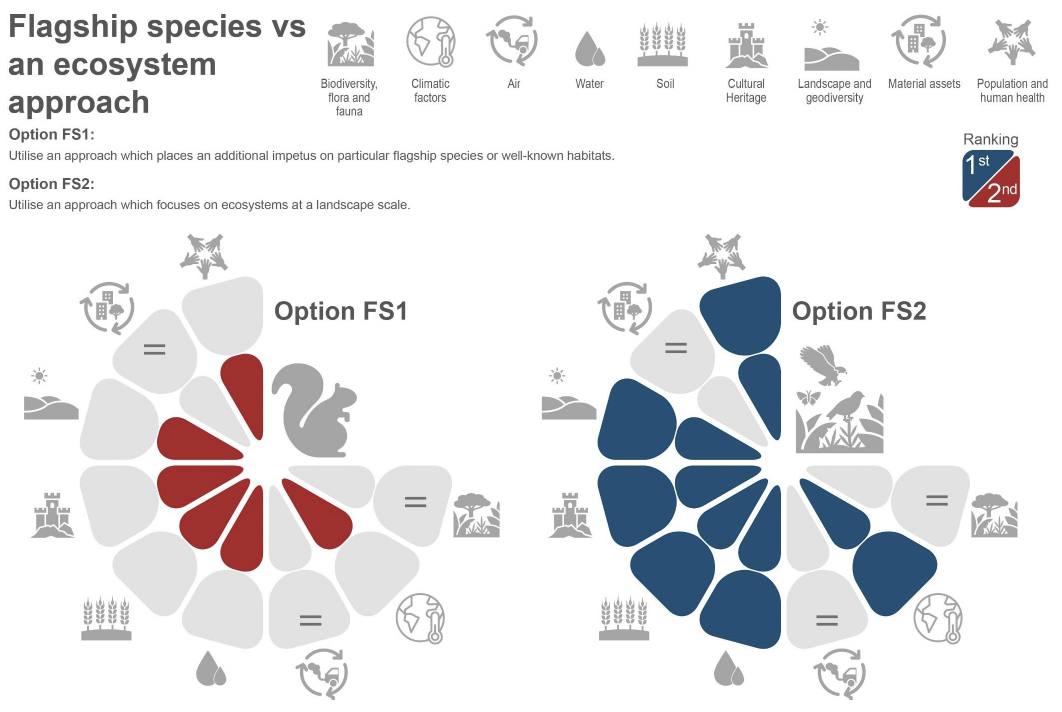
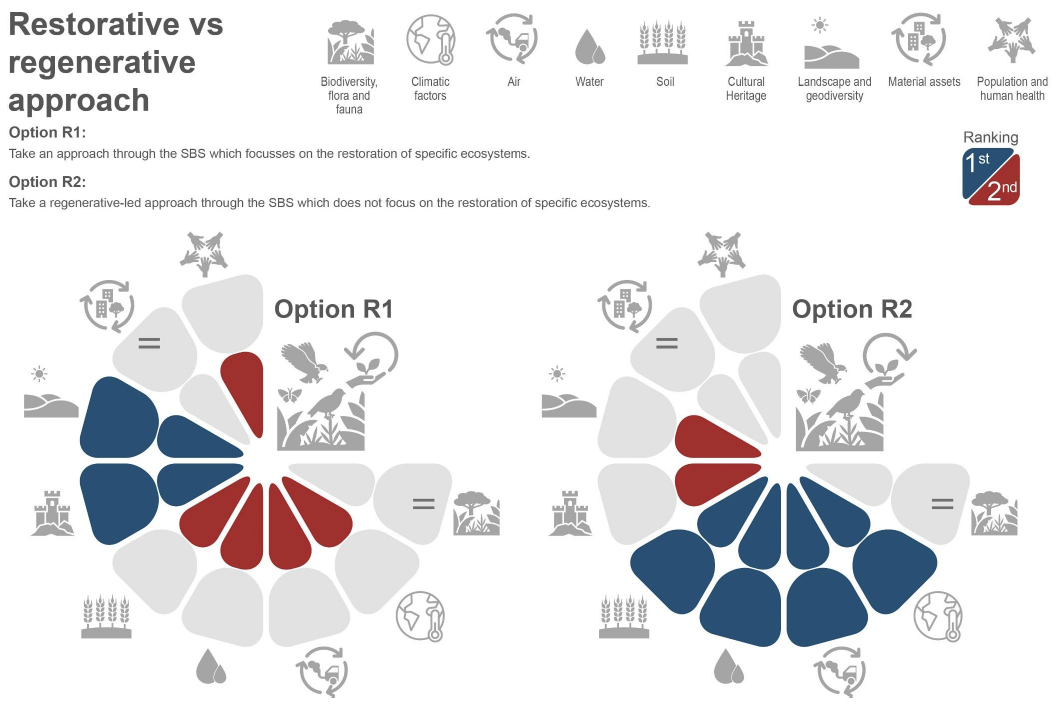
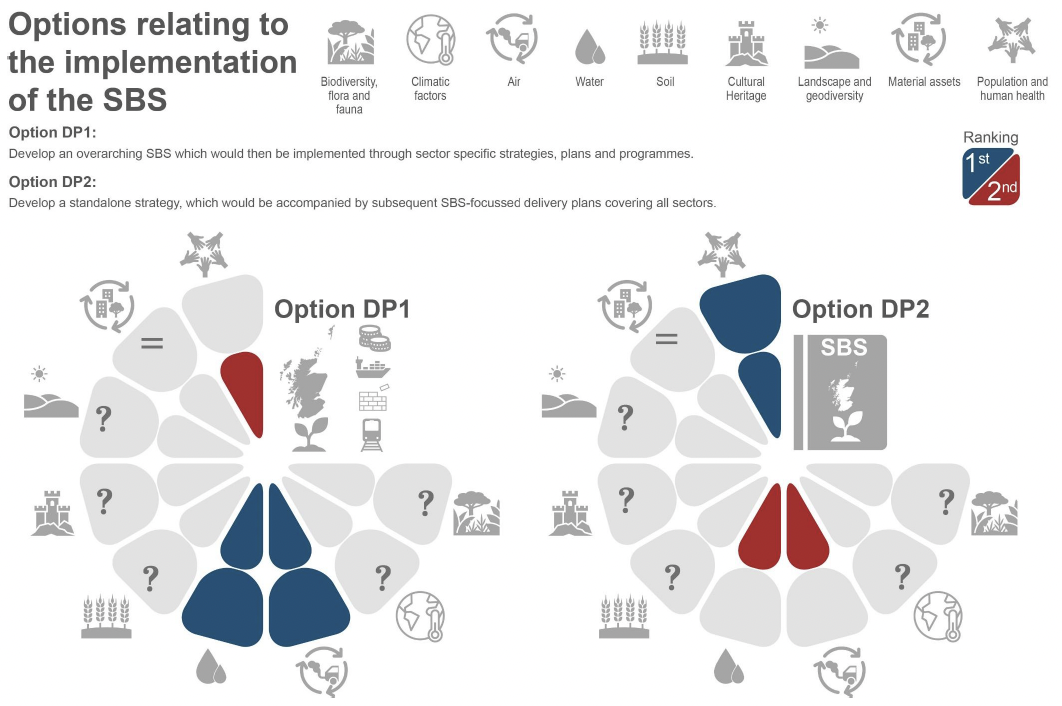
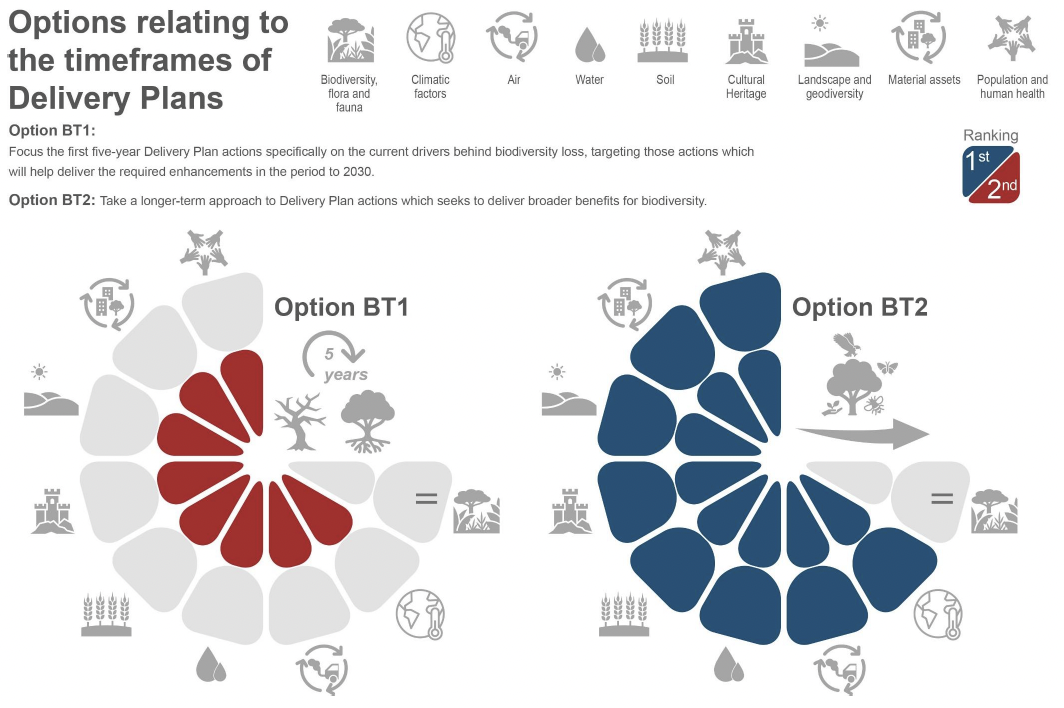
Assessment of SBS & Delivery Plan
Chapter 6 of the Environmental Report presents an assessment of the current version of the SBS & Delivery Plan.
The SBS has been introduced by Scottish Government to halt biodiversity loss and accelerate nature recovery. The Strategy aims for Scotland to be Nature Positive by 2030 (having halted biodiversity loss by this point in time) and to have restored and regenerated biodiversity across the country by 2045. The SBS will sit alongside Scotland's Climate Change Plan and contribute to Scotland's commitment to Net Zero.
The Strategy is supported by the first Delivery Plan, which covers the period 2023 to 2028 and builds upon the vision and outcomes articulated by the Strategy. The Strategy and Delivery Plan form part of a Strategic Delivery Framework aimed at providing the enabling conditions for success. In addition to the SBS and Delivery Plan, as part of this framework, Scottish Government will also introduce a Natural Environment Bill to put in place statutory targets for nature conservation, an Investment Plan setting out the cost of identified actions and investment drivers, and a monitoring and reporting framework to measure the effectiveness of actions.
The Strategy has identified priority actions for the period up to 2030 which will assist Scotland in becoming Nature Positive. These actions are explored in more detail and built upon through the Delivery Plan. Together the documents present 33 priority actions across six broad objectives. The first five objectives are identified in the Strategy and broadly tackle direct drivers; they are:
- Accelerate restoration and regeneration.
- Safeguard land and sea.
- Support nature-friendly farming, fishing, and forestry.
- Recover and protect vulnerable and important species and habitats.
- Invest in nature.
The Delivery Plan adds an additional sixth objective to 'act on the indirect drivers of change for biodiversity' and breaks down the 33 priority actions into some 145 detailed actions.
The SBS & Delivery Plan proposals have been assessed against the SEA Framework developed during scoping, with the detailed findings of the assessment presented in Chapter 6 of the Environmental Report. The infographic below identifies the key significant effects identified through this assessment.
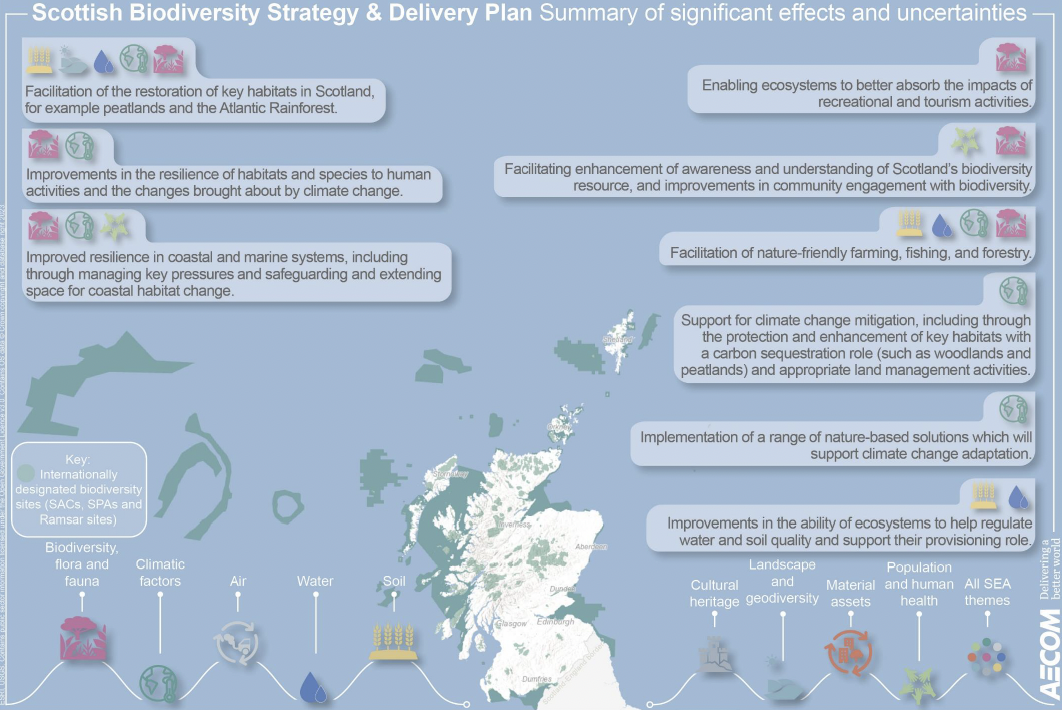
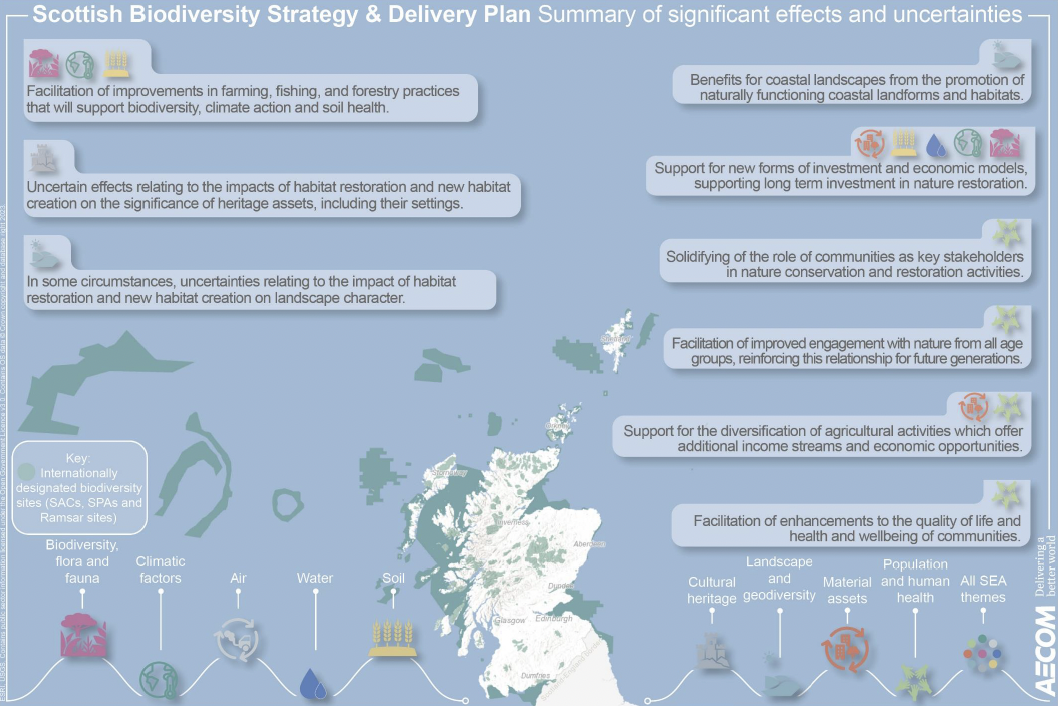
Overall, the assessment of the SBS & Delivery Plan highlights that there are no likely significant negative effects arising as a result of the proposals. In addition there are, broadly, no conflicts between the objectives of the SBS and the SEA objectives. This is reflected by the conclusions of significant or minor positive effects against all SEA topics.
In this respect the assessment has highlighted that there are a range of actions outlined by the Delivery Plan that will support the protection and enhancement of the environment across Scotland, whilst also benefitting the quality of life and health and wellbeing of its communities. This includes relating to the objectives to address the twin crises of biodiversity loss and climate change, crises which ultimately affect natural resources, air, water, and soil quality, landscapes, and human health.
The assessment has however highlighted some uncertainties with regards to the effect of habitat restoration and new habitat creation on the fabric and setting of the historic environment and landscape character.
To help ensure that the environmental value of the proposals are maximised, and the uncertainties identified through the assessment are addressed, a number of recommendations can be made for the implementation of the SBS & Delivery Plan.
These are as follows:
- Mechanisms should be implemented to ensure that the location, species and scale of planting avoids negative impacts to historic environment assets, e.g. to archaeological sites or the setting of a listed building, or to minimise these and maximise opportunities for enhancement.
- Habitat restoration and re-creation should be informed by appropriate research and historic environment/landscape character assessments. In this respect appropriate methods for enhancements should be devised with input from historic environment and landscape specialists from the outset.
- Biodiversity enhancements should be appropriately designed to reinforce the special qualities of a landscape. The design of biodiversity enhancements should therefore be sensitive to the surrounding landscape, and exercises in habitat restoration and creation should be carefully selected to complement existing character and setting.
SEA monitoring programme
Schedule 2 of the Environmental Assessment (Scotland) Act highlights that the Environmental Report should include "a description of the measures envisaged concerning monitoring."
Monitoring in SEA is a means of evaluating the environmental performance of the plan or strategy and monitoring compliance through its implementation. It is also a way to check whether the effects predicted in the SEA arise as envisaged, or whether unforeseen issues arise.
Chapter 0 therefore sets out a proposed preliminary monitoring programme for measuring the SBS & Delivery Plan's implementation. It pays particular attention to the areas where the SEA has identified potential significant effects and also suggests where monitoring is required to help ensure that the positive effects of the proposals are achieved through implementation.
Next steps
This Environmental Report is being consulted on alongside the Delivery Plan.
Following the completion of the consultation period in November 2023, comments will be reviewed and analysed. Any changes arising to the proposals will need to be assessed as part of the SEA process.
Part 3 of the Environmental Assessment (Scotland) Act 2005 requires that a 'statement' be made available to accompany the proposals, as soon as possible after their adoption. The purpose of the SEA Adoption Statement is to outline how the SEA process has influenced and informed the proposals' development process and demonstrate how consultation on the SEA has been taken into account.
To meet these requirements, an SEA Adoption Statement will be published with the adopted Delivery Plan. The SEA Adoption Statement will set out: the reasons for choosing the preferred SBS & Delivery Plan in light of other reasonable alternatives; how environmental considerations were integrated into the SBS & Delivery Plan's development process; how consultation responses were taken into account; and the measures decided for monitoring the significant effects of the proposals.
Contact
There is a problem
Thanks for your feedback